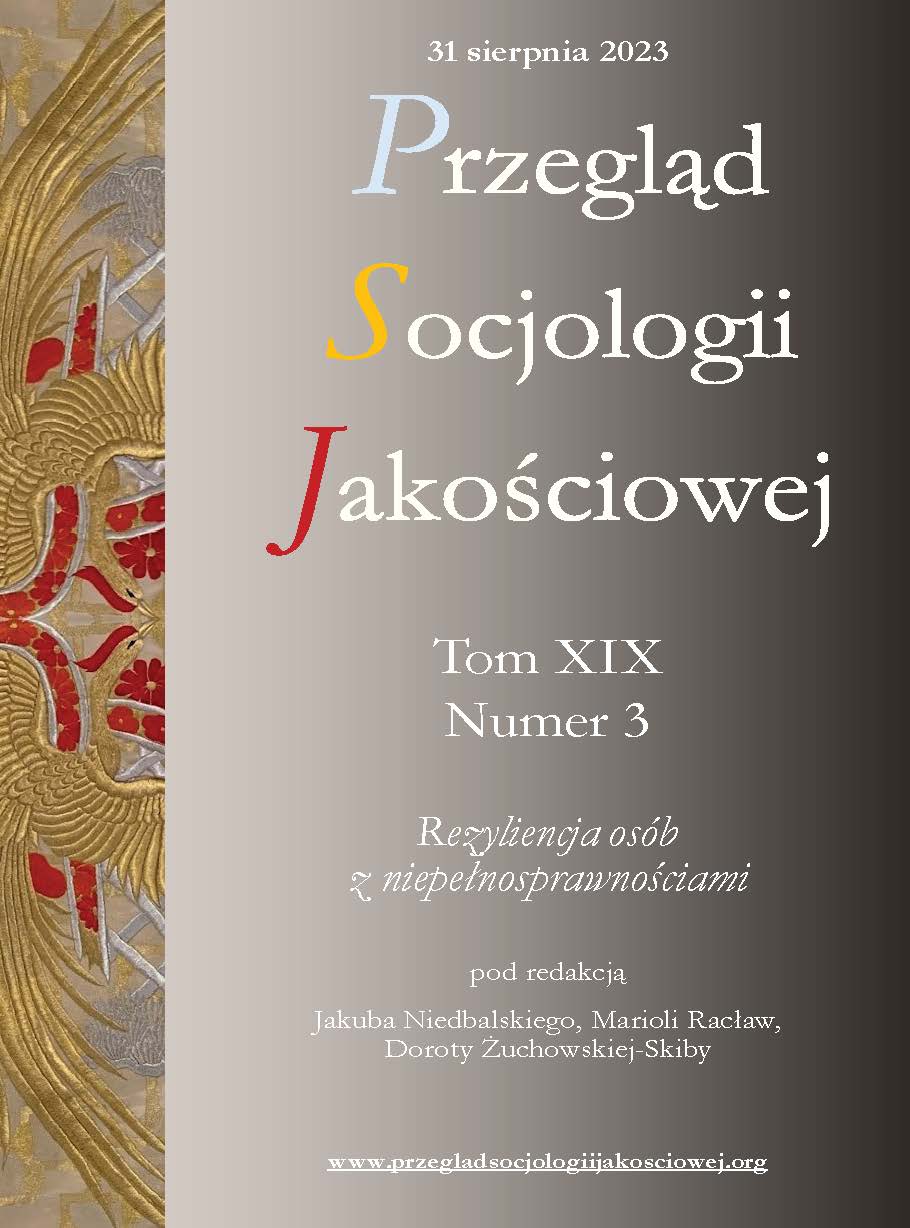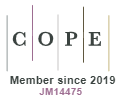Znaczenie mediów społecznościowych dla osób z niepełnosprawnościami w Polsce podczas epidemii COVID-19
DOI:
https://doi.org/10.18778/1733-8069.19.3.05Słowa kluczowe:
media społecznościowe, niepełnosprawność, epidemia COVID-19, izolacja, wykluczenieAbstrakt
Osoby z niepełnosprawnościami w okresie epidemii COVID-19 były szczególnie narażone na wykluczenie informacyjne, np. konferencje prasowe nie były tłumaczone na PJM, brakowało informacji w języku prostym itp. Dodatkowo wprowadzone zostały ograniczenia w kontaktach społecznych i możliwości realizowania dotychczasowych aktywności oraz korzystania ze wsparcia wolontariuszy, asystentów. Sprawiło to, że w tym okresie istotną rolę odegrały media społecznościowe, które często były jedyną możliwością kontaktu z szerszym otoczeniem oraz własną społecznością, a także stanowiły miejsce, gdzie można było uzyskać wsparcie, podtrzymać relacje społeczne i otrzymać informacje dotyczące epidemii i wprowadzanych ograniczeń.
Celem artykułu jest ukazanie znaczenia mediów społecznościowych w okresie epidemii koronawirusa w Polsce w latach 2020–2021 dla osób z niepełnosprawnościami. Przeprowadzone badania netnograficzne oparte zostały na analizie treści opublikowanych w dziesięciu grupach skupiających osoby z niepełnosprawnościami w okresach od marca do kwietnia 2020 roku i od grudnia 2020 do lutego 2021 roku na portalu społecznościom Facebook.
Uzyskane wyniki badań wskazują, że media społecznościowe w czasie sytuacji kryzysowej, jaką była pandemia, odegrały ważną rolę dla osób z niepełnosprawnościami. Analiza treści profili grup na portalach społecznościowych pokazała, że stanowią one przestrzeń poszukiwania i wymiany informacji, dzielenia się obawami, poszukiwania wsparcia oraz walki o swoje prawa przez osoby z niepełnosprawnościami.
Pobrania
Bibliografia
Alathur Sreejith, Pai Rajesh (2023), Usefulness and barriers of adoption of social media for disability services: an empirical analysis, “Transforming Government: People, Process and Policy”, vol. 17(1), pp. 147–171.
Google Scholar
Alathur Sreejith, Kottakkunnummal Manaf, Chetty Naganna (2021), Social media and disaster management: influencing e-participation content on disabilities, “Transforming Government: People, Process and Policy”, vol. 15(4), pp. 566–579, https://doi. org/10.1108/TG-07-2020-0155
Google Scholar
Andreassen Hege, Bujnowska-Fedak Maria, Chronaki Catherine, Dumitru Roxana, Pudule Ivete, Santana Silvina, Voss Henning, Wynn Rolf (2007), European citizens’ use of E-health services: A study of seven countries, “BMC Public Health”, vol. 53(7), pp. 1–7, https://doi.org/10.1186/1471-2458-7-53
Google Scholar
Armitage Richard, Nellums Laura (2020), The COVID-19 response must be disability inclusive, “The Lancet Public Health”, vol. 5(5), pp. 257–261, https://www.thelancet.com/journals/lanpub/article/PIIS2468-2667(20)30076-1/fulltext ( accessed: 5.03.2023).
Google Scholar
Banerjee Debanjan, Rai Mayank (2020), Social isolation in Covid-19: The impact of loneliness, “International Journal of Social Psychiatry”, vol. 66, pp. 525–527.
Google Scholar
Boyle Coleen, Fox Michael, Havercamp Susan, Zubler Jennefer (2020), The public health response to the COVID-19 pandemic for people with disabilities, “Disability and Health Journal”, vol. 13(3), pp. 1–4, https://doi.org/10.1016/j.dhjo.2020.100943
Google Scholar
Burke Lucy, Crow Liz (2017), Bedding Out: Art, Activism and Twitter, [in:] Katie Ellis, Mike Kent (eds.), Disability and the social media: Global perspectives, London: Routledge, pp. 57–74.
Google Scholar
Chanda Srei, Sekher T.V. (2020), Disability during COVID-19: Increasing vulnerability and neglect, “Economic and Political Weekly”, vol. 55(30), pp. 30–33.
Google Scholar
Dobransky Kerry, Hargittai Eszter (2016), Unrealized potential: Exploring the digital disability divide, “Poetics”, vol. 58, pp. 18–28.
Google Scholar
Dobransky Kerry, Hargittai Eszter (2020), People with Disabilities During COVID-19, “Contexts”, vol. 19(4), pp. 46–49, https://doi.org/10.1177/1536504220977935
Google Scholar
Dobransky Kerry, Hargittai Eszter (2021), Piercing the pandemic social bubble: Disability and social media use about COVID-19, “American Behavioral Scientist”, vol. 65, pp. 1698–1720.
Google Scholar
Ellis Katie, Goggin Gerard, Halle Beth, Curtis Rosemary (2019), Disability and Media – An Emergent Field, [in:] Kate Ellis, Gerard Goggin, Beth Haller, Rosemary Curtis (eds.), The Routledge Companion to Disability and Media, New York: Routledge, pp. 5–15.
Google Scholar
Goggin Gerard (2015), Communication rights and disability online: Policy and technology after the World Summit on the Information Society, “Information, Communication and Society”, vol. 18(3), pp. 327–341.
Google Scholar
Goggin Gerard, Newell Christopher (2003), Digital disability: The social construction of disability in new media, Lanham: Rowman and Littlefield.
Google Scholar
Hay Kathryn, Pascoe Margaret (2019), Disabled people and disaster management in New Zealand: examining online media messages, “Disability and Society”, vol. 34(2), pp. 253–275, https://doi.org/10.1080/09687599.2018.1545114
Google Scholar
Headland Thomas (1990), Introduction: a dialogue between Kenneth Pike and Marvin Harris on emics and etics, [in:] Kenneth L. Pike, Marvin Harris (eds.), Emics and etics: The insider/outsider debate, London: Sage Publications, pp. 13–27.
Google Scholar
Huang Shiwei, Wang Yuwei (2023), How People with Physical Disabilities Can Obtain Social Support through Online Videos: A Qualitative Study in China, “International Journal of Environmental Research and Public Health”, vol. 20(3), pp. 2423–2437, https://doi.org/10.3390/ijerph20032423
Google Scholar
Juszczyk-Rygałło Joanna (2018), Nowe media jako element kształtowania kapitału społecznego ich użytkowników, “Media i Społeczeństwo”, vol. 8, pp. 51–60.
Google Scholar
Kampert Amy, Goreczny Anthony J. (2007), Community involvement and socialization among individuals with mental retardation, “Research in Developmental Disabilities”, vol. 28(3), pp. 278–286, https://doi.org/10.1016/j.ridd.2005.09.004
Google Scholar
Kent Mike (2020), Social media and disability: It’s complicated, [in:] Katie Ellis, Gerard Goggin, Beth Haller, Rosemary Curtis (eds.), Routledge companion to disability and the media, New York: Routledge, pp. 264–274.
Google Scholar
Kent Mike, Ellis Kelly (2015), People with disability and new disaster communications: access and the social media mash-up, “Disability and Society”, vol. 30(3), pp. 419–431.
Google Scholar
Klemm Paula, Bunnell Dyane, Cullen Maureen, Soneji Rachna, Gibbons Patricia, Holecek Andrea (2003), Online Cancer Support Groups: A Review of the Research Literature, “CIN: Computers, Informatics, Nursing”, vol. 21, pp. 136–142, https://doi.org/10.1097/00024665-200305000-00010
Google Scholar
Kocejko Magdalena (2021), Sytuacja dzieci z niepełnosprawnościami w czasie pandemii COVID-19 – analiza intersekcjonalna, “Dziecko Krzywdzone. Teoria, Badania, Praktyka”, vol. 20(2), pp. 76–91.
Google Scholar
Kocejko Magdalena, Bakalarczyk Rafał, Kubicki Paweł (2021), Wpływ pandemii koronawirusa na politykę wobec niepełnosprawności i starości, [in:] Artur Zybała, Krzysztof Księżopolski, Andrzej Bartosiewicz (eds.), Polska… Unia Europejska… Świat w pandemii COVID-19. Wybrane zagadnienia, Warszawa: Dom Wydawniczy Elipsa, pp. 96–116.
Google Scholar
Li Hanlin, Bora Disha, Salvi Sagar, Brady Erin (2018), Slacktivists or Activists? Identity Work in the Virtual Disability March, Proceedings of the 2018 CHI Conference on “Human Factors in Computing Systems”, vol. 225, pp. 1–13, https://doi.org/10.1145/3173574.3173799
Google Scholar
Lin Zhongxuan, Yang Liu, Zhang Zhi’an (2018), To include, or not to include that is the question: disability digital inclusion and exclusion in China, “New Media and Society”, vol. 20(12), pp. 4436–4452.
Google Scholar
Masłyk Tomasz, Migaczewska Ewa, Stojkow Maria, Żuchowska-Skiba Dorota (2016), Aktywni niepełnosprawni? Obywatelski i społeczny potencjał środowiska osób niepełnosprawnych, Kraków: Wydawnictwa Akademii Górniczo-Hutniczej.
Google Scholar
Morris John, Mueller James, Jones Michael (2014), Use of social media during public emergencies by people with disabilities, “The Western Journal of Emergency Medicine”, vol. 15(5), pp. 567–574.
Google Scholar
Nguyen Minh Hao, Hargittai Eszter, Marler Will (2021), Digital inequality in communication during a time of physical distancing: The case of COVID-19, “Computers in Human Behavior”, no. 120, 106717.
Google Scholar
Nguyen Minh Hao, Gruber Jonathan, Fuchs Jaelle, Marler Will, Hunsaker Amanda, Hargittai Eszter (2020), Changes in Digital Communication During the COVID-19 Global Pandemic: Implications for Digital Inequality and Future Research, “Social Media + Society”, vol. 6(3), pp. 1–6.
Google Scholar
Nguyen Minh Hao, Gruber Jonathan, Marler Will, Hunsaker Amanda, Fuchs Jaelle, Hargittai Eszter (2021), Staying connected while physically apart: Digital communication when face-to-face interactions are limited, “New Media and Society”, vol. 24(9), pp. 1–8, https://doi.org/10.1177/1461444820985442
Google Scholar
Patel Jay, Nielsen Freja, Badiani Ashni A., Assi Sarah, Unadkat Vrajeshkumar, Patel Bakula, Ravindrane Ramyadevi, Wardle Heather (2020), Poverty, inequality and COVID-19: the forgotten vulnerable, “Public Health”, vol. 183, pp. 110–111.
Google Scholar
Poppen William, Bradley Natalie (2003), Assistive technology, computers and Internet may decrease sense of isolation for homebound elderly and disabled persons, “Technology and Disability”, vol. 15(1), pp. 19–25, https://doi.org/10.3233/TAD-2003-15104
Google Scholar
Przedłużamy etap odpowiedzialności i wprowadzamy dodatkowe ograniczenia – zamknięte stoki i nowe zasady bezpieczeństwa w Sylwestra (2020), https://www.gov.pl/web/koronawirus/przedluzamy-etap-odpowiedzialnosci-i-wprowadzamy-dodatkowe-ograniczenia (accessed: 5.03.2023).
Google Scholar
Robinson Laura, Schulz Jeremy, Khilnani Aneka, Ono Hiroshi, Cotten Shelia R., McClain Noah, Levine Lloyd, Chen Wenhong, Huang Gejun, Casilli Antonio A., Tubaro Paola, Dodel Matias, Quan-Haase Anabel, Ruiu Maria L., Ragnedda Massimo, Aikat Deb, Tolentino Natalia (2020), Digital inequalities in time of pandemic: COVID-19 exposure risk profiles and new forms of vulnerability, “First Monday”, vol. 25(7), pp. 1–7.
Google Scholar
Roland Damian, Spurr Jesse, Cabrera Daniel (2017), Preliminary evidence for the emergence of a health care online community of practice: Using a netnographic frame work for twitter hashtag analytics, “Journal of Medical Internet Research”, vol. 19(7), pp. 252–265.
Google Scholar
Smieszek Mateusz (2021), Aktywność i głos osób z dysfunkcjami sensorycznymi na portalach społecznościowych. Raport z badań netnograficznych, “Praca Socjalna”, vol. 36(6), pp. 37–65.
Google Scholar
Smieszek Mateusz, Borowska-Beszta Beata (2017), Nethnographic Research Report on Families with Members with Disabilities in Social Media and Facebook, “Psycho-Educational Research Reviews”, vol. 6(2), pp. 89–102.
Google Scholar
Shoham Snunith, Heber Meital (2012), Characteristics of a virtual community for individuals who are d/deaf and hard of hearing, “American Annals of the Deaf”, vol. 157(3), s. 251–263.
Google Scholar
Stojkow Maria, Żuchowska-Skiba Dorota (2014), Od porad medycznych ku prozie życia – czyli przemiany dyskursu osób z niepełnosprawnościami w Internecie, “Niepełnosprawność – Zagadnienia, Problemy, Rozwiązania”, no. 3, pp. 41–55.
Google Scholar
Stojkow Maria, Żuchowska-Skiba Dorota (2015), Aktywność osób z niepełnosprawnościami na profilach i forach społecznościowych w społeczeństwie sieci, “Polityka Społeczna”, vol. 42(5), pp. 17–21.
Google Scholar
Stróżyk Agata (2020), Pandemia koronawirusa na świecie i w Polsce – kalendarium, https://www.medicover.pl/o-zdrowiu/pandemia-koronawirusa-na-swiecie-i-w-polsce-kalendarium,7252,n,192 (accessed: 5.03.2023).
Google Scholar
Sweet Kayla S., LeBlanc Jennifer K., Stough Laura M., Sweany Noelle W. (2020), Community building and knowledge sharing by individuals with disabilities using social media, “Journal of Computer Assisted Learning”, vol. 36, pp. 1–11.
Google Scholar
Toquero Cathy M.D. (2020), Inclusion of People with Disabilities amid COVID-19: Laws, Interventions, Recommendations Multidisciplinary, “Journal of Educational Research”, vol. 10(2), pp. 158–177.
Google Scholar
Uden-Kraan Cornelia van, Drossaert Constance, Taal Erik, Shaw Bret, Seydel Ervin, Laar Mart van de (2008), Empowering processes and outcomes of participation in online support groups for patients with breast cancer, arthritis, or fibromyalgia, “Qualitative Health Research”, vol. 18, pp. 405–417.
Google Scholar
United Nations (2020), Policy Brief: A Disability-Inclusive Response to COVID-19, https://unsdg.un.org/resources/policy-brief-disability-inclusive-response-covid-19 (accessed: 12.02.2023).
Google Scholar
Verdegem Pieter (2011), Social Media for Digital and Social Inclusion: Challenges for Information Society 2.0 Research & Policies, “Triple C”, vol. 9(1), pp. 28–38, https://doi.org/10.31269/vol9iss1pp28-38
Google Scholar
Wright Kevin (2016), Social Networks, Interpersonal Social Support and Health Outcomes: A Health Communication Perspective, “Front Community”, vol. 1, pp. 10–19, https://doi.org/10.3389/fcomm.2016.00010
Google Scholar
Wright Kevin, Bell Sally (2003), Health-related Support Groups on the Internet: Linking Empirical Findings to Social Support and Computer-mediated Communication Theory, “Journal of Health Psychology”, vol. 8(1), pp. 39–57, https://doi.org/10.1177/1359105303008001429
Google Scholar
Zielińska-Pękał Daria (2014), Wykorzystanie strategii emicznej w badaniach nad poradniczymi praktykami wspólnot wirtualnych, “Dyskursy Młodych Andragogów/Adult Education Discourses”, vol. 15, pp. 154–169.
Google Scholar
Żuchowska-Skiba Dorota (2018), Niepełnosprawność w dobie Web 2.0. Znaczenie portali społecznościowych dla osób z niepełnosprawnościami, [in:] Ewa Grudziewska, Marta Mikołajczyk (eds.), Wybrane problemy społeczne: teraźniejszość – przyszłość, Warszawa: Wydawnictwo Akademii Pedagogiki Specjalnej, pp. 138–148.
Google Scholar
Żuchowska-Skiba Dorota (2021), The social dimension of the Internet from the perspective of people with disabilities during the Covid-19 pandemic, “Przegląd Socjologiczny”, vol. 70(3), pp. 31–47.
Google Scholar
Pobrania
Opublikowane
Wersje
- 2023-10-27 - (2)
- 2023-08-31 - (1)
Jak cytować
Numer
Dział
Licencja

Utwór dostępny jest na licencji Creative Commons Uznanie autorstwa – Użycie niekomercyjne – Bez utworów zależnych 4.0 Międzynarodowe.
Funding data
-
Akademia Górniczo-Hutnicza im. Stanislawa Staszica
Grant numbers “Excellence initiative – research university”














